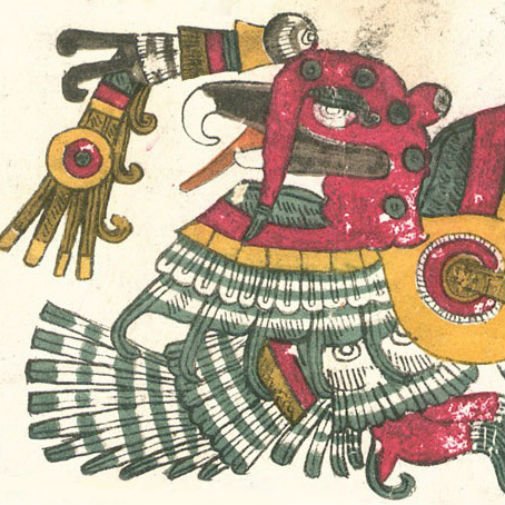Not just for Christmas: Study sheds new light on ancient human-turkey relationship
Posted on 17 January 2018

Turkey illustration from the Codex Borgia, a pre-Hispanic document from Southern Mexico. Wikimedia Commons.
The study also suggests turkeys weren’t only prized for their meat - with demand for the birds soaring with the Mayans and Aztecs because of their cultural significance in rituals and sacrifices.
In an international collaboration, researchers from the University of York, the Institute of Anthropology and History in Mexico, Washington State University and Simon Fraser University, studied the remains of 55 turkeys which lived between 300BC and 1500 AD.
The birds had been discovered in Mesoamerica- an area stretching from central Mexico to Northern Costa Rica within which pre-Columbian societies such as the Mayans and Aztecs flourished.
Ancient DNA
Analysing the ancient DNA of the birds, the researchers were able to confirm that modern European turkeys are descended from Mexican ancestors.
The team also measured the carbon isotope ratios in the turkey bones to reconstruct their diets. They found that the turkeys were gobbling crops cultivated by humans such as corn in increasing amounts, particularly in the centuries leading up to Spanish exploration, implying more intensive farming of the birds.
Interestingly, the gradual intensification of turkey farming does not directly correlate to an increase in human population size, a link you would expect to see if turkeys were reared simply as a source of nutrition.
Important cultural and symbolic role
Lead author of the paper and Marie Skłodowska-Curie Fellow in the Department of Archaeology at the University of York, Dr Aurélie Manin, said: “Turkey bones are rarely found in domestic refuse in Mesoamerica and most of the turkeys we studied had not been eaten – some were found buried in temples and human graves, perhaps as companions for the afterlife. This fits with what we know about the iconography of the period, where we see turkeys depicted as gods and appearing as symbols in the calendar.
“The archaeological evidence suggests that meat from deer and rabbit was a more popular meal choice for people in pre-Columbian societies; turkeys are likely to have also been kept for their increasingly important symbolic and cultural role”.
The fact that some of the turkey bones were uncovered outside of the natural range of the species also suggests that there was a thriving turkey trade in live birds along Mesoamerica’s expanding trade routes.
Senior author of the paper from the Department of Archaeology at the University of York, Dr Camilla Speller, said: “Even though humans in this part of the word had been practicing agriculture for around 10,000 years, the turkey was the first animal, other than the dog, people in Mesoamerica started to take under their control.
“Turkeys would have made a good choice for domestication as there were not many other animals of suitable temperament available and turkeys would have been drawn to human settlements searching for scraps”
Roaming free
Some of the remains the researchers analysed were from a cousin of the common turkey – the brightly plumed Ocellated turkey. In a strange twist the researchers found that the diets of these more ornate birds remained largely composed of wild plants and insects, suggesting that they were left to roam free and never domesticated.
“Why two biologically very similar species living in the same area were treated so differently remains a mystery,” added Dr Speller.
This same team continues to explore the origins of Mesoamerican domestic turkeys through a US National Science Foundation grant led by Dr Erin Kennedy Thornton from Washington State University, where they will examine how the shape, size and genetic makeup of archaeological turkey bones to understand how the wild turkeys of Mexico were transformed into the birds we find on our tables today.
Further information:
- Diversity of management strategies in Mesoamerican turkeys: archaeological isotopic and genetic evidence is reported today in Royal Society Open Science: http://rsos.royalsocietypublishing.org/content/5/1/171613
Explore more news

Sodium channels in breast cancer cells a promising target for future treatments, study reveals
Thursday 25 July 2024

Cooling the classroom: University of York researchers to investigate UK schools’ responses to hot weather
Wednesday 24 July 2024

Hunter-gatherers kept an 'orderly home' in the earliest known British dwelling, study shows
Tuesday 23 July 2024

Study uses Game of Thrones to advance understanding of face blindness
Tuesday 23 July 2024

York academic contributes to new report on men’s health which reveals disparities between most and least deprived areas in the UK
Wednesday 17 July 2024
Media enquiries
About this research
This research was carried out by Dr Aurélie Manin, Dr Camilla Speller and Dr Michelle Alexander from the Department of Archaeology. The study was supported by a postdoctoral fellowship from the Social Sciences and Humanities Research Council (SSHRC) of Canada; a Philip Leverhulme Prize; a postdoctoral fellowship from the Fyssen Foundation and support from the Instituto Nacional de Antropologia e Historia.
